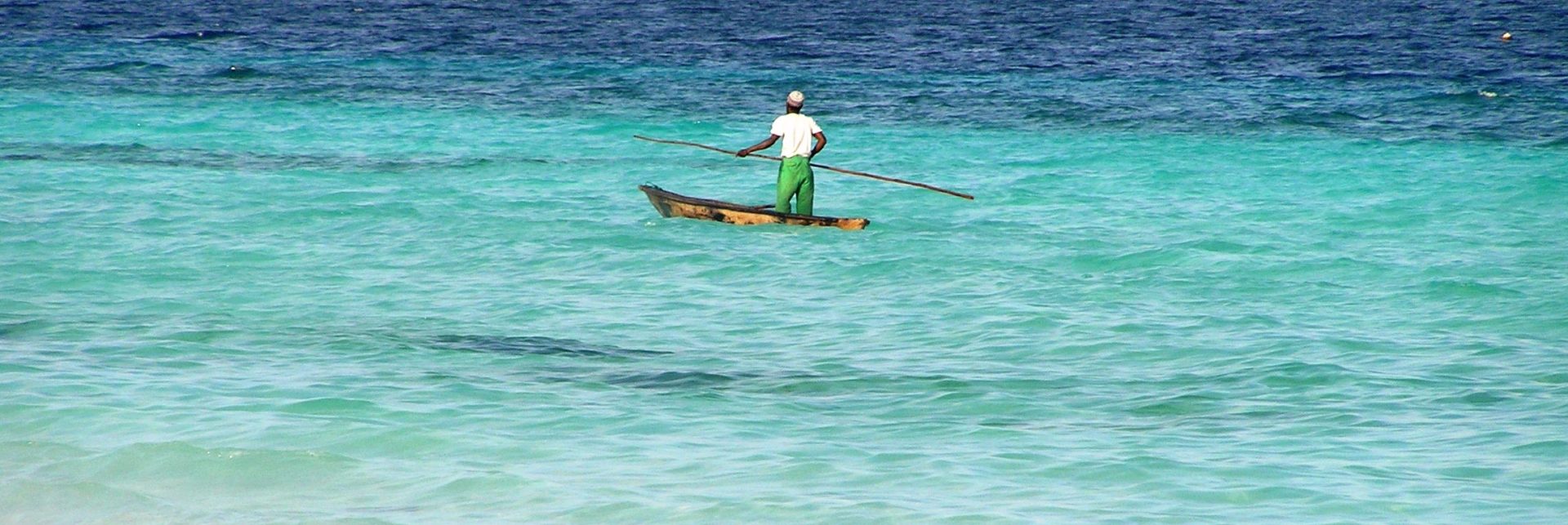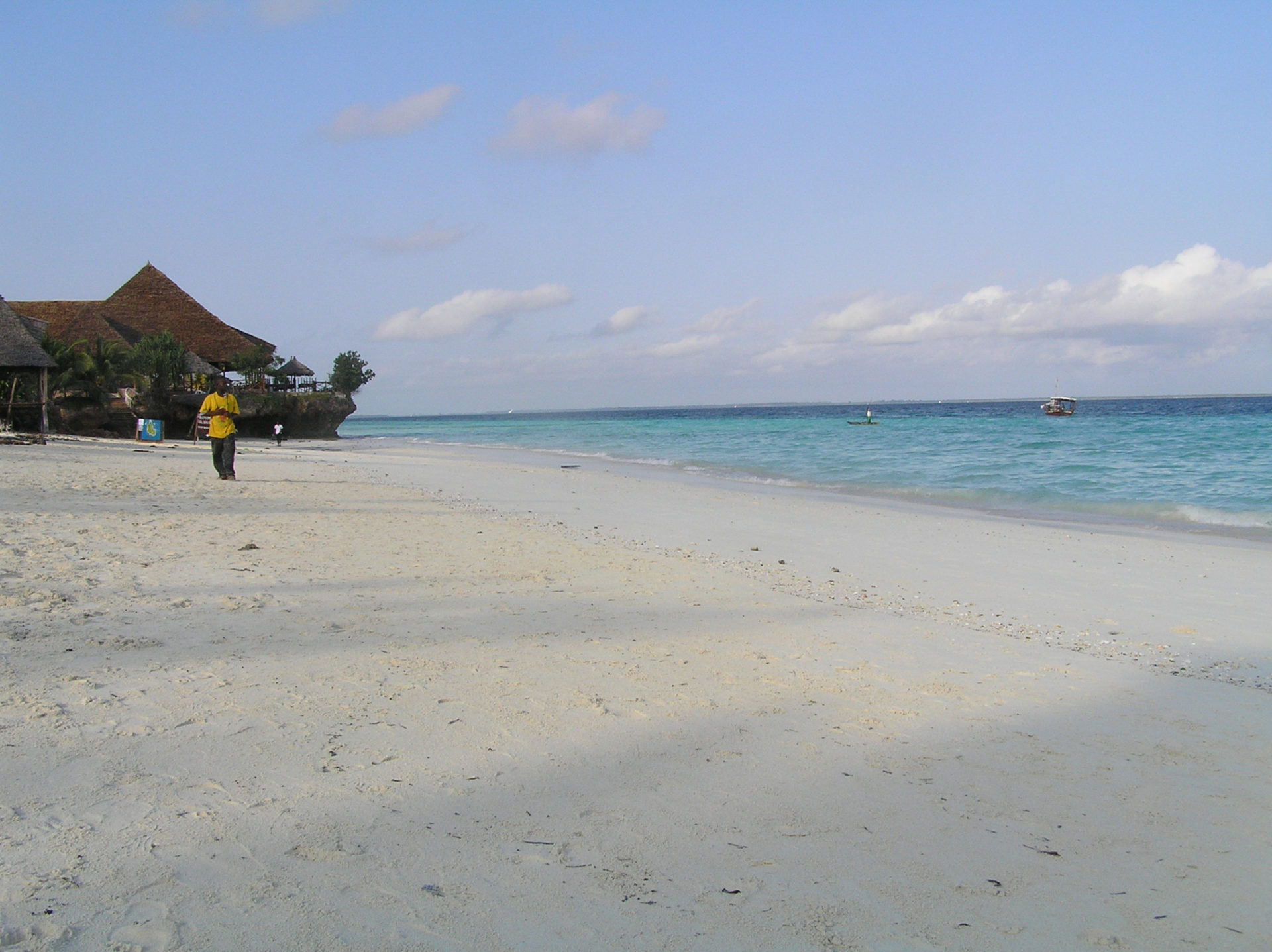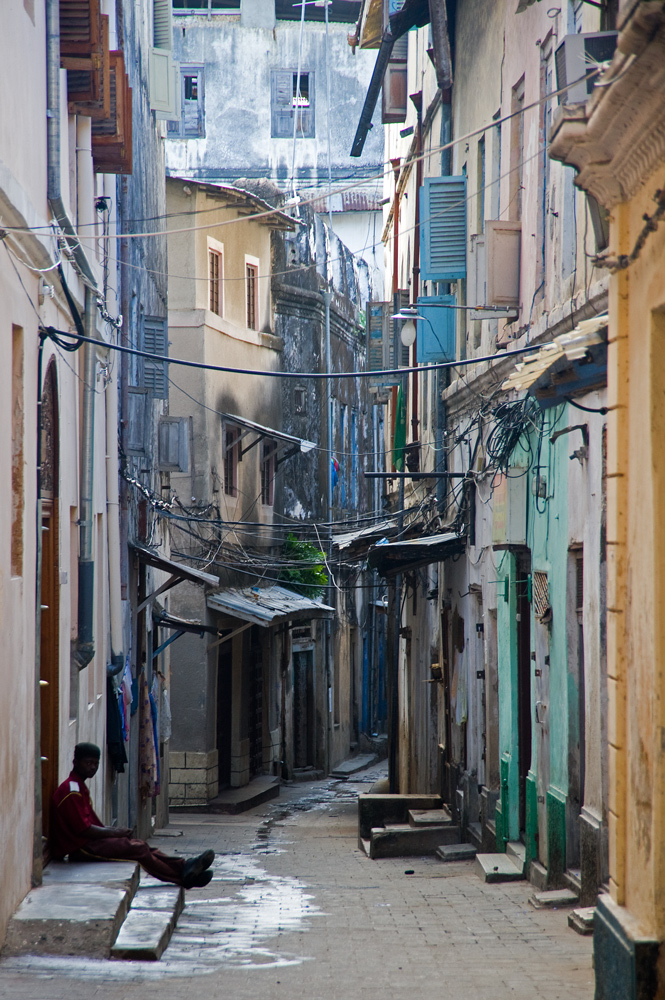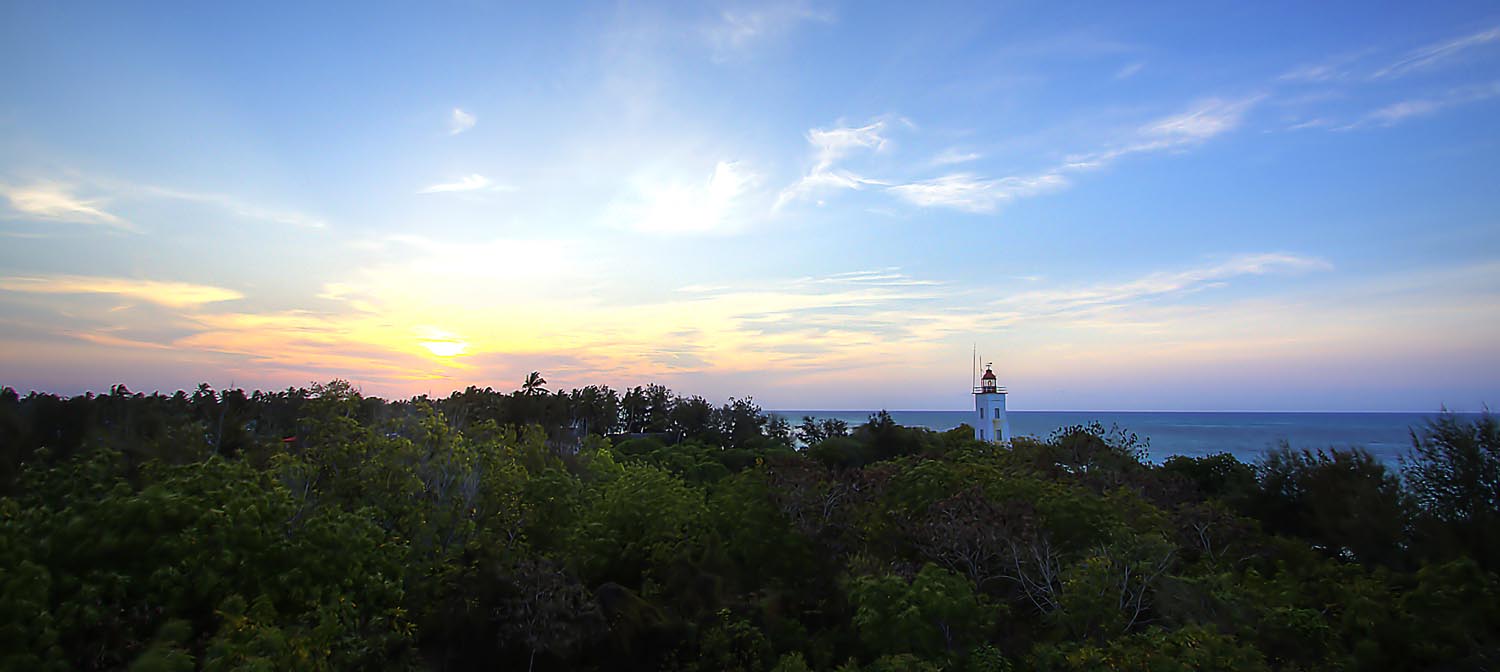Zanzibar
Zanzibar is an archipelago off the coast of Tanzania. Zanzibar consists of two large islands and several smaller ones. The main island is actually called Unguja but commonly known as Zanzibar Island. To avoid confusion, we always mean the individual island of Unguja when we write Zanzibar and when we talk about the archipelago we write the Zanzibar Archipelago.
Zanzibar's medieval capital Zanzibar Town is usually called Stone Town even though Stone Townm is actually just the old center of the city and Zanzibar Town is much bigger than Stone Town. Stone Town is one of the UNESCO World Heritage Sites and a place worth visiting. Zanzibar's neighboring Island Pemba is significantly less famous but also it offers amazing beaches, diving and snorkeling.
Zanzibar is located in the Indian Ocean about 6 km from mainland Tanzania and about 6 degrees south of the equator. Zanzibar is about 100 km long and 30 km wide and is characterized by white sandy beaches, colorful coral reefs, turquoise waters and the stunning capital of Stone Town.
The name Zanzibar is believed to come from the Persian words Zangi-bar (roughly the coast of black people). The Arabic name for Zanzibar is Zanji Bar. It is also possible that the name stems from the spice ginger, also known as Zingiber. Zanzibar has long been called the Spice Islands, a name they share with the moluccas islands in Indonesia.
Stone Town
Most of the houses in Stone Town (or Mji Mkongwe in KiSwahili) were built in the 19th century when Zanzibar was one of the most important hubs of trade in the Indian Ocean. However, the houses are built in soft stones that erode, which is clearly visible in many houses whose condition is rapidly deteriorating. The Stone Town Conservation Authority works to preserve this heritage for the future. Thanks to this work, almost all hotels in Zanzibar are housed in beautifully renovated 1800 century houses.
The place where Stone Town is now has probably been inhabited since more than 300 yearshundred years, but there are no houses preserved since that time.
Two large houses dominate the other cityscape. The first is Beit-El-Ajaib or a “House of Wonder”, built by Sultan Seyid Bargash as a ceremony palace. The second is the Arabic fortress that was once a Portuguese building which was converted into a fortification in the 18th century.
The city was the center of trade on the east coast of Africa, as well as between Asia and Europe during the period before the inland of Africa was colonized in the late 1800’s. Then the center of gravity was moved to Mombasa and Dar Es Salaam. The most important export products from Zanzibar during this period were spices. For many years, Stone Town was also the center of slave trade in East Africa. The Anglican Cathedral of Stone Town is built in the place where there was previously a slave market.
Stone Town also became an important starting point for European colonizers, especially the Portuguese. David Livingstone used the city as the starting point for his last trip in Africa in 1866.
Less known facts about Stone Town are, for example, that Freddie Mercury, the now deceased singer in the English rock band Queen, is born here.
Climate
Zanzibar, like the whole of Tanzania’s coastal areas, has tropical climate. The weather is warm all year but sometimes markedly moderated by sea breeze, especially in the north and on the east coast. For a European it is difficult to talk about summer and winter on Zanzibar but officially it is high summer in December and January and winter in June, July. Rainy periods are mainly late November to mid to late December, called the short rain, and March-early June, called the long rain.
The clear majority of rainfall during the long rain falls in March and April. However, Zanzibar has a typical tropical climate and the rain and dry periods are not as marked as in some parts of the inland. This means that rain can occur at all times of the year. With the exception of the long rain, however, it is unusual for long lasting rain, especially for several days in a row.
Wildlife and nature
Zanzibar has no large land animals, except perhaps the legendary Zanzibar leopard that is said to live in the Jozani forest. However, the Zanzibar leopard is commonly believed to be extinct even if some who think there are actually some leopards left in the woods. Otherwise, the forests of Zanzibar are inhabited by smaller animals such as monkeys, mungos, wild boar and smaller antelopes. Zanzibar also has many bird species and, in the countryside, many different species of butterflies. Zanzibar’s richest wildlife is found in the many coral reefs surrounding the island and the smaller islands near Zanzibar. This makes Zanzibar a paradise for scuba diving, diving and snorkeling. The best snorkeling and diving site in Zanzibar is Mnemba Island outside northeastern Zanzibar. Also Chapwani Island, outside Stone Town, as well as Nungwi and Kendwa in northern Zanzibar are good places for snorkeling and scuba diving.
Culture and religion
Through a changing history, Zanzibar has had a cultural and ethnic mix between African, Arabic, Indian and, to some extent, also European. The dominant religion is Islam, which more than 90 percent of the population confess to. The rest are mostly Christians and Hindus. Swahili is Zanzibar’s official language and the language almost every Zanzibari has as a native language. It is often said, especially in Zanzibar, that the Swahili that is spoken here is the purest form of Swahili, partly because the language originates from Zanzibar. Zanzibar’s population amounts to approximately 1 300 000 people, of which nearly 250 000 live in the capitol Zanzibar Town.
Zanzibar’s most celebrated cultural event is the International Film Festival, organized in July each year. This shows not only movies but also art and music from all over Swahili culture.
Politics and economy
Zanzibar is part of the United Republic of Tanzania but is partly autonomous. Zanzibar has its own parliament and government that decides on local issues and Zanzibar also has its own president, who is also vice president of Tanzania.
Fishing and agriculture are traditionally the dominant parts of Zanzibar’s economy and they also employ a large part of the population. Nowadays tourism the most important business of Zanzibar and, above all, it is on the main island of Unguja.
Zanzibar was previously the world’s largest spice exporter, and this product accounted for a very large part of the country’s economy. Although spices are still an important export product, as well as spices and coconut products, tourism is the sector that the local government is making the most effort to bring in foreign currency. Tourism is also a steadily increasing sector with more tourists each year.
Our favourite hotels in Zanzibar
Do you want to add a vacation in Zanzibar after your safari? We are happy to help you book a hotel. Below are some of our favourite hotels.
Hotels in northern Zanzibar
Mnarani Beach Cottages – a basic mid-range hotel on the northern tip of Zanzibar. The standard rooms are quite small and basic but the deluxe and superior rooms are much bigger and nicer for not that much extra. The hotel is on a cliff above a lovely beach. The beach is tidal, and swimming is not possible at the lowest tide. The hotel has about 30 rooms and they offer rooms on half board basis. It is a perfect place if you want a small and personal lodge with good value for money. It is not for those of you who look for a luxurious stay in Zanzibar.
Z Hotel – a design hotel with a more international than truly Zanzibari feeling. Don’t get us wrong, the place is lovely, but it might by design just as well have been a Caribbean or Mediterranean hotel. The standard is very good both on service and rooms. It is very popular with honeymooners and couples and less good for families. The hotel is located right on the best beach in Nungwi Village. The downside is that this beach is quite busy.
Doubletree By Hilton Nungwi Resort – an international chain hotel of good standard that offers all-inclusive stay on a great beach in Nungwi. It is a perfect hotel for those of you who enjoy the all-inclusive concept and for families with children. The hotel does BBQ on the beach a few nights a week, weather permitting. The hotel has several interconnected rooms perfect for those of you travelling with children or teenagers.
Kendwa Rocks – A budget to mid-range hotel on a beautiful beach in Kendwa just south of Zanzibar’s northern tip. The hotel has rooms in many categories, where the cheapest rooms are very basic, and the bigger more expensive rooms are of a higher mid-range standard. The hotel is popular with young people as it has a big stretch och beach, a big bar, a night club and once a month party on the beach. It is not for those seeking a quiet vacation, reading books on the beach
The Zanzibari – a small boutique hotel on the eastern side of Nungwi, Zanzibar’s northern tip, on a very quiet beach. The Zanzibari has just 8 standard rooms (4 garden view and 4 sea view) and three suites so it is never crowded. The beach is very secluded but the difference between high and low tide is big and swimming is not possible at low tide. There are also steep steps from the hotel down to the beach. The service and food are great, and the atmosphere is lovely. This is a hotel for honeymooners and couples, not for families with teenagers and/or children.
Hotels in north eastern Zanzibar
Zanzibar Retreat – a small personal boutique hotel on a lovely beach within sight of the famous Mnemba Island. The hotel has just a dozen rooms and it very appreciated for it’s personal service. The owner lives and works on the hotel. They service and food is great. The two garden view rooms are smaller and less good than the rest of the rooms that have partial or full sea view.
Sunshine Marine Hotel – a nice hotel in the upper mid-range section. The hotel is rustic and very Zanzibari in design. It has large rooms decorated in colors inspired by the Indian ocean, turquoise, green, blue. It has two pool’s and a pier from which you can swim in the ocean, but it does not have a beach. The restaurant and bar are nice. The hotel has the same owners as the two adjacent hotels Sunshine Hotel and Zanzibar Pearl. Sunshine Marine Hotel has divers as it’s main clientele and it does have a dive center and a deep pool where test diving and training is done.
Sunshine Hotel – very similar in style to it’s sister hotel Sunshine Marine but less focused on divers and it does have a beach., The style and standard of rooms, restaurant and bar is very similar to that of Sunshine Marine Hotel.
Zanzibar Pearl Hotel – of the three adjacent hotels, managed and owned by the same owner, in our opinion, Zanzibar Pearl Hotel is the nicest. Although very similar in style, design, feeling and service our feeling is that everything is just a little bit better here. The beach is nicer, the rooms are slightly larger, the restaurant area is bigger, so if you are choosing between the three Zanzibar Pearl is the one we recommend, even though the price is slightly higher.
Hotels in south eastern Zanzibar








